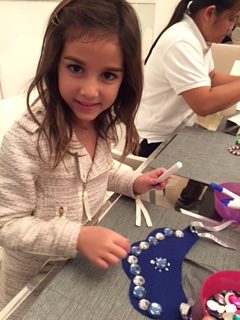7 Hidden Gems in the Hamptons
Whether you live in the East End or you’re looking to get out of Manhattan for a day, the Hamptons provide a wealth of environmental treasures for families. These destinations evoke a sense of wonder, awe, and imagination in young and old alike. Shine play groups meet at some of these locations on a weekly basis, while others we visit for special events, parties, and workshops. With the Indian summers we’ve been having, autumn is the perfect season to get out and explore some of these hidden gems at a time when the crowds are thin.
LongHouse Reserve
Stroll this 16-acre sculpture garden to find a giant chess board designed by Yoko Ono, a beautiful pond with lotus plants and frogs on lily pads, and Buckminster Fuller’s iconic “Fly’s Eye Dome,” designed with water collection systems and solar panels as a “self-sufficient home of the future.” Kids delight in the maze-like layout, while embarking upon a scavenger hunt for the unique and captivating. All ages are welcome, but the ideal age is six and up, as they are less likely to climb on the sculptures, shout at the top of their lungs, or be tempted to play hide-and-seek.
Visit: 133 Hands Creek Road, East Hampton, 613-604-5330, www.longhouse.org
Bridge Gardens
Part of the Peconic Land Trust, designed to preserve Long Island’s working farms and natural lands, the five acres of Bridge Gardens offer the perfect respite from City life for birdwatching, painting, photography, and nature study in the heart of Bridgehampton. The land boasts a collection of perennial and annual beds, as well as hedgerows and herb gardens. The garden hosts many educational and family-friendly events in partnership with Shine and the local children’s museum.
Visit: 36 Mitchell Lane, Bridgehampton, 631-537-7440, www.peconiclandtrust.org
Children’s Museum of the East End
Parents and children alike will enjoy the magic of this interactive play center geared toward ages 2-7. The town-like setting takes families through a farmers’ market, a windmill, a potato chip factory, a 1950s diner, a library, a fire station, a construction site, a pirate shipwreck, and a musical forest. Active children will delight in the wooden climbing structures, soft foam areas, and slides. Keep an eye out for classes, workshops, and special performances throughout the year.
Visit: 376 Bridgehampton-Sag Harbor Turnpike, Bridgehampton, 631-537-8250, www.cmee.org
Amber Waves Farm
Amber Waves was founded in 2009 to produce healthy, organic food for the local community such as wheat, popcorn, and over 300 varieties of fruits, vegetables, and cutting flowers. You’ll also see dozens of chickens running about. Guided tours, pizza-making workshops, story hours, toddler play groups, and a hands-on Farm Club program are all part of the family-oriented experience.
Visit: 367 Main Street, Amagansett, 631-267-5664, www.amberwavefarms.org
Madoo Conservancy
Madoo is an enchanting oasis – from the pruned boxwood and grove of ginkgos of the central walkway and the Chinese bridge overlooking a pond, to the blue wrought-iron gated gardens and the fairytale cottages with yellow doors. With free admission, there’s really no excuse to miss out on this local landmark and tribute to artist/gardener Robert Dash. Children’s programming includes storytelling in the gardens from 10-11 am on Monday mornings through October 7th. During the summer months, they offer an art program based on East End painters for kids ages 5-8.
Madoo is an enchanting oasis – from the pruned boxwood and grove of ginkgos of the central walkway and the Chinese bridge overlooking a pond, to the blue wrought-iron gated gardens and the fairytale cottages with yellow doors. With free admission, there’s really no excuse to miss out on this local landmark and tribute to artist/gardener Robert Dash. Children’s programming includes storytelling in the gardens from 10-11 am on Monday mornings through October 7th. During the summer months, they offer an art program based on East End painters for kids ages 5-8.
Visit: 618 Sagg Main Street, Sagaponack, 631-537-8200, www.madoo.org
Nova’s Ark
Artist Nova Mihai Popa hoped the enormous sculptures set on the 95 acres of Nova’s Ark would “reflect the spirit and knowledge all around us.” One can’t help but be impressed by the bronze-colored structures reaching over five stories high. While you’re there, stop by to see the resident grazing sheep and the majestic horses boarded at Big Sky Ranch. The Ark serves as a great introduction to unique architectural styles, with the Elliptical House (designed to have a small ecological footprint), the Castle Barn celebration center (renovated from an old dairy barn), and the Cities of the Future (cosmic brick homes that can be easily replicated in factories).
Visit: 60 Millstone Road, Water Mill, 631-537-0061, www.thearkproject.com
Wölffer Estate Winery
This vineyard is assuredly kid-friendly. Co-owner Joey Wölffer explains, “There is nothing better than having my daughters at the Wine Stand with me on Friday and Saturday nights. Kids love to run around and play together, and it’s a great place to bring the family.” Across the road from the main vineyard, music starts at 5:00 pm and runs through the end of September. Bring blankets and chairs to enjoy a sunset picnics with wines by the bottle and glass, cheese and charcuterie platters, as well as beverages and snack boxes with raisins, string cheese, and Goldfish crackers available for the kids. During the summer months, Wölffer runs a pony camp for kids. (Nearby Channing Daughters winery is another one of our kid-friendly favorites.)
Visit: 3312 Montauk Highway, Sagaponack, 631-537-5106, www.wolffer.com
Contact us to learn more about child enrichment programs and idyllic escapes in the East End.








